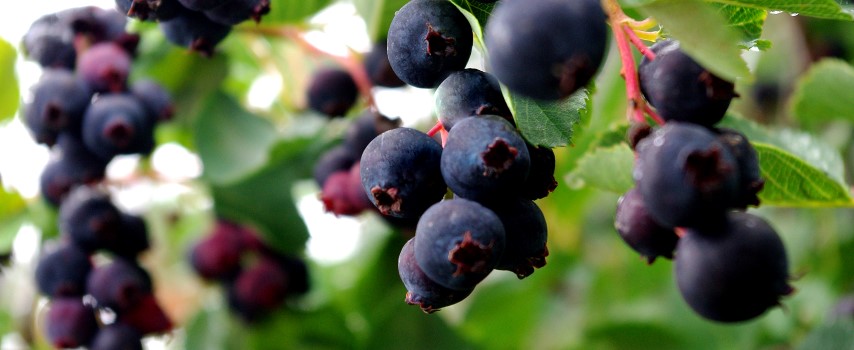Saskatoon Variety Evaluation
Research Importance
Saskatoon, also known as serviceberry (Amelanchier sp.), has been an essential part of the Canadian prairie landscape and produce market for decades. Its bluish-purple fruits resemble blueberries but are more closely related to apples or pears. The shrubs are highly adapted to cold climates, neutral soils and have a sweet, almond-like flavor. If you’ve ever tasted saskatoons in the wild, you might be skeptical, but horticultural cultivars have been bred to produce a much larger and juicier berry. Additionally, these domesticated berries are high in fiber, protein, and antioxidants. Because saskatoons grow vigorously in conditions similar to those found in Montana, this trial seeks to determine which varieties may prove most successful and useful in local markets.
Research Summary
In 2015, six saskatoon cultivars were planted at four locations across the state (Corvallis-WARC, Bozeman-MSU, Kalispell-FVCC, and Helena). At all sites, each cultivar was represented by 9 plants (3 plants/block x 3 blocks). Plant qualities assessed annualy include survival, disease issues, yield, berry weight, and sugar content (⁰ Bx).
Results
Saskatoons are susceptible to a multitude of pests and disease, and our experience growing them at the Corvallis site held true to this reputation. In 2018, the saskatoon sawfly (Hoplocampa montanicola), and saskatoon juniper rust (Gymnosporangium nelsonii, also known as Cedar-apple rust) infected several plants. The saskatoon sawfly can cause significant amounts of fruit drop, sometimes resulting in the loss of an entire crop. Apple rust does minor damage to plants but can result in deformed and unmarketable fruit. However, these pests remained manageable in our trials with monitoring and timely chemical sprays.
In terms of appearance and taste, an informal blind taste test at the Corvallis site rated 'Northline', 'Martin', and 'Lee 8' as more desirable than other varieties. 'Smoky' was less visually appealing as was JB30. JB30 also tested poorly for flavor (Table 1).
| Cultivar | Appearance | Flavor |
|---|---|---|
| JB30 | 3.2 | 2.5 |
| Lee 8 | 3.6 | 3.3 |
| Martin | 3.6 | 3.5 |
| Northline | 4.2 | 3.5 |
| Smoky | 2.5 | 3.5 |
Yields in 2018 averaged approximately 1.5 to over 10 lbs/plant depending on variety. Later fruiting varieties, 'Lee 8' and 'Northline', showed significantly higher yields (p<0.0001) than any other variety in the trial, averaging 11.5 and 11.6 lbs/plant, respectively. All other varieties produced fewer lbs/plant; averages are listed in Table 2.
| Yield (lbs/plant) | |||||||
|---|---|---|---|---|---|---|---|
| Cultivar | 2017 | 2018 | 2019 | 2020 | 2021 | Single Fruit Weight (g) |
Sugar (°Bx) |
| JB30 | 0.2 | 1.2 | 2.7 | 2.8 | 6.8 | 1.3 | 18.3 |
| Lee 3 | 0.5 | 4.2 | 4.6 | 9.1 | 6.4 | 1.1 | 15.1 |
| Lee 8 | 0.4 | 11.5 | 7.1 | 8.2 | 8.7 | 0.9 | 15.7 |
| Martin | 0.3 | 3.4 | 3.2 | 9.0 | 6.4 | 1.4 | 16.9 |
| Northline | 0.5 | 11.6 | 4.4 | 18.3 | 8.4 | 0.9 | 15.9 |
| Smoky | 0.1 | 8.5 | 5.7 | 16.7 | 9.8 | 0.9 | 15.9 |
High Pectin Content
As demonstrated in this short video, saskatoons have a high pectin content, making them suitable for jams and jellies or requiring the addition of pectinase during winemaking.
Conclusions
While very hardy, saskatoons require a considerable amount of pest management in order to ensure consistent yield and high-quality fruit. 'Northline' and 'Lee 8' appear to be favorable varieties for Western Montana growers as these varieties produced high yields and exhibited favorable appearance and flavor. It should be noted, however, that 'Smoky' produced relatively high yields and also exhibited favorable appearance and flavor. 'JB30' has not proven to be a reliable choice for local growers, given its tendency towards low yields and unappealing flavor.
Publications
University of Idaho-production guide
Saskatoon Berry Institute: a grower and processor group-mainly based in Michigan.


